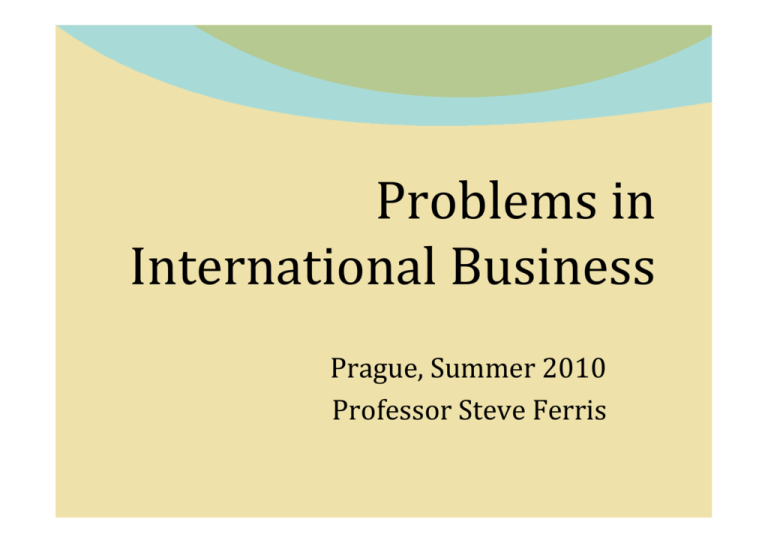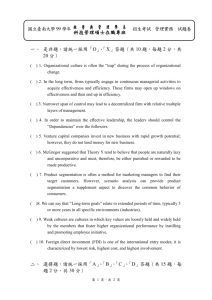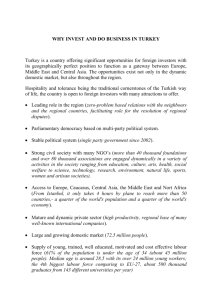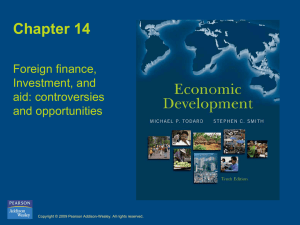
Problems in
International Business
Prague, Summer 2010
Professor Steve Ferris
Lecture 6
Foreign Direct
Investment
McGraw-Hill/Irwin
Copyright © 2011 by the McGraw-Hill Companies, Inc. All rights reserved.
What Is FDI?
Foreign direct investment (FDI) occurs when a firm
invests directly in new facilities to produce and/or market
in a foreign country
the firm becomes a multinational enterprise
FDI can be in the form of
greenfield investments - the establishment of a wholly new
operation in a foreign country
acquisitions or mergers with existing firms in the foreign country
The flow of FDI refers to the amount of FDI undertaken
over a given time period
Outflows of FDI are the flows of FDI out of a country
Inflows of FDI are the flows of FDI into a country
The stock of FDI refers to the total accumulated value of
foreign-owned assets at a given time
7-3
What Are The Patterns Of FDI?
Both the flow and stock of FDI have increased over the last 30 years
Most FDI is targeted towards developed nations - United States and EU
South, East, and South East Asia - China – and Latin America are emerging
FDI has grown more rapidly than world trade and world output
firms still fear the threat of protectionism
democratic political institutions and free market economies have
encouraged FDI
globalization is forcing firms to maintain a presence around the world
Gross fixed capital formation - the total amount of capital invested in
factories, stores, office buildings, and the like
the greater the capital investment in an economy, the more favorable its
future prospects are likely to be
So, FDI is an important source of capital investment and a determinant
of the future growth rate of an economy
7-4
What Are The Patterns Of FDI?
FDI Outflows 1982-2008 ($ billions)
7-5
What Are The Patterns Of FDI?
FDI Inflows by Region 1995-2008 ($ billion)
7-6
What Are The Patterns Of FDI?
Inward FDI as a % of Gross Fixed Capital Formation 1992-2007
7-7
What Is The Source Of FDI?
Since World War II, the U.S. has been the
largest source country for FDI
the United Kingdom, the Netherlands, France,
Germany, and Japan are other important source
countries
together, these countries account for 56% of all
FDI outflows from 1998-2006, and 61% of the
total global stock of FDI in 2007
7-8
What Is The Source Of FDI?
Cumulative FDI Outflows 1998-2007 ($ billions)
7-9
Why Do Firms Choose Acquisition
Versus Greenfield Investments?
Most cross-border investment is in the form of
mergers and acquisitions rather than greenfield
investments
Firms prefer to acquire existing assets because
mergers and acquisitions are quicker to execute than
greenfield investments
it is easier and perhaps less risky for a firm to acquire
desired assets than build them from the ground up
firms believe that they can increase the efficiency of an
acquired unit by transferring capital, technology, or
management skills
7-10
Why Does FDI In Services Occur?
FDI is shifting away from extractive industries and
manufacturing, and towards services
The shift to services is being driven by
the general move in many developed countries toward
services
the fact that many services need to be produced where
they are consumed
a liberalization of policies governing FDI in services
the rise of Internet-based global telecommunications
networks
7-11
Why Choose FDI?
1.
Exporting - producing goods at home and then shipping them to the
receiving country for sale
2.
exports can be limited by transportation costs and trade barriers
FDI may be a response to actual or threatened trade barriers such as
import tariffs or quotas
Licensing - granting a foreign entity the right to produce and sell the
firm’s product in return for a royalty fee on every unit that the
foreign entity sells
Internalization theory (aka market imperfections theory)
suggests that licensing has three major drawbacks compared to FDI
firm could give away valuable technological know-how to a potential
foreign competitor
does not give a firm the control over manufacturing, marketing, and
strategy in the foreign country
the firm’s competitive advantage may be based on its management,
marketing, and manufacturing capabilities
7-12
What Is The Pattern Of FDI?
Why do firms in the same industry undertake FDI at about the same
time and the same locations?
Knickerbocker - FDI flows are a reflection of strategic rivalry between
firms in the global marketplace
multipoint competition -when two or more enterprises encounter each
other in different regional markets, national markets, or industries
Vernon - firms undertake FDI at particular stages in the life cycle of a
product
But, why is it profitable for firms to undertake FDI rather than
continuing to export from home base, or licensing a foreign firm?
According to Dunning’s eclectic paradigm- it is important to consider
location-specific advantages - that arise from using resource
endowments or assets that are tied to a particular location and that a firm
finds valuable to combine with its own unique assets
externalities - knowledge spillovers that occur when companies in the
same industry locate in the same area
7-13
What Are The Theoretical
Approaches To FDI?
The radical view - the MNE is an instrument of imperialist domination
and a tool for exploiting host countries to the exclusive benefit of their
capitalist-imperialist home countries
The free market view- international production should be distributed
among countries according to the theory of comparative advantage
embraced by advanced and developing nations including the United States,
Britain, Chile, and Hong Kong
Pragmatic nationalism - FDI has both benefits (inflows of capital,
technology, skills and jobs) and costs (repatriation of profits to the
home country and a negative balance of payments effect)
FDI should be allowed only if the benefits outweigh the costs
Recently, there has been a strong shift toward the free
market stance creating
a surge in FDI worldwide
an increase in the volume of FDI in countries with newly liberalized
regimes
7-14
How Does FDI Benefit
The Host Country?
1.
2.
3.
4.
There are four main benefits of inward FDI for a host
country
Resource transfer effects - FDI brings capital,
technology, and management resources
Employment effects - FDI can bring jobs
Balance of payments effects - FDI can help a country to
achieve a current account surplus
Effects on competition and economic growth greenfield investments increase the level of competition
in a market, driving down prices and improving the
welfare of consumers
can lead to increased productivity growth, product and process
innovation, and greater economic growth
7-15
What Are The Costs Of
FDI To The Host Country?
1.
Inward FDI has three main costs:
Adverse effects of FDI on competition within the host
nation
2.
Adverse effects on the balance of payments
3.
subsidiaries of foreign MNEs may have greater economic power
than indigenous competitors because they may be part of a
larger international organization
when a foreign subsidiary imports a substantial number of its
inputs from abroad, there is a debit on the current account of the
host country’s balance of payments
Perceived loss of national sovereignty and autonomy
decisions that affect the host country will be made by a foreign
parent that has no real commitment to the host country, and
over which the host country’s government has no real control
7-16
How Does FDI Benefit
The Home Country?
The benefits of FDI for the home country include
1. The effect on the capital account of the home
country’s balance of payments from the inward
flow of foreign earnings
2. The employment effects that arise from outward
FDI
3. The gains from learning valuable skills from
foreign markets that can subsequently be
transferred back to the home country
7-17
What Are The Costs Of
FDI To The Home Country?
1. The home country’s balance of payments can suffer
from the initial capital outflow required to finance the FDI
if the purpose of the FDI is to serve the home market from a low
cost labor location
if the FDI is a substitute for direct exports
2. Employment may also be negatively affected if the FDI is
a substitute for domestic production
But, international trade theory suggests that home
country concerns about the negative economic effects of
offshore production (FDI undertaken to serve the home
market) may not be valid
7-18
How Does Government
Influence FDI?
Governments can encourage outward FDI
government-backed insurance programs to cover major types of
foreign investment risk
Governments can restrict outward FDI
limit capital outflows, manipulate tax rules, or outright prohibit FDI
Governments can encourage inward FDI
offer incentives to foreign firms to invest in their countries
gain from the resource-transfer and employment effects of FDI, and
capture FDI away from other potential host countries
Governments can restrict inward FDI
use ownership restraints and performance requirements
7-19
How Do International
Institutions Influence FDI?
Until the 1990s, there was no consistent
involvement by multinational institutions in
the governing of FDI
Today, the World Trade Organization is
changing this by trying to establish a
universal set of rules designed to promote
the liberalization of FDI
7-20
What Does FDI
Mean For Managers?
Managers need to consider what trade theory implies
about FDI, and the link between government policy and
FDI
The direction of FDI can be explained through the locationspecific advantages argument associated with John
Dunning
However, it does not explain why FDI is preferable to exporting or
licensing, must consider internalization theory
A host government’s attitude toward FDI is an important
variable in decisions about where to locate foreign
production facilities and where to make a foreign direct
investment
7-21
What Does FDI
Mean For Managers?
A Decision Framework
7-22
Review Question
The establishment of a wholly new operation
in a foreign country is called
A) an acquisition
B) a merger
C) a greenfield investment
D) a multinational venture
7-23
Review Question
The amount of FDI undertaken over a given
time period is known as
A) the flow of FDI
B) the stock of FDI
C) FDI outflow
D) FDI inflow
7-24
Review Question
Most FDI is direct toward
a) developed countries
b) emerging economies
c) the United States
d) China
7-25
Review Question
Advantages that arise from using resource
endowments or assets that are tied to a particular
location and that a firm finds valuable to combine
with its own unique assets are
a) First mover advantages
b) Location advantages
c) Externalities
d) Proprietary advantages
7-26
Review Question
Benefits of FDI include all of the following
except
a) The resource transfer effect
b) The employment effect
c) The balance of payments effect
d) National sovereignty and autonomy
7-27
Review Question
Which of the following is not a cost of outward FDI
for host countries?
a) the initial capital outflow required to finance the
FDI
b) when FDI is a substitute for direct exports
c) gains from learning valuable skills from foreign
markets
d) the effect on employment is FDI is a substitute for
domestic production
7-28










